
A steamboat is a boat that is propelled primarily by steam power, typically driving propellers or paddlewheels. Steamboats sometimes use the prefix designation SS, S.S. or S/S or PS ; however, these designations are most often used for steamships.

Belle of Louisville is a steamboat owned and operated by the city of Louisville, Kentucky, and moored at its downtown wharf next to the Riverfront Plaza/Belvedere during its annual operational period. The steamboat claims itself the "most widely traveled river steamboat in American history." Belle of Louisville's offices are aboard Mayor Andrew Broaddus, and also appears on the list of National Historic Landmarks.

The Delta Queen is an American sternwheel steamboat. She is known for historically cruising the major rivers that constitute the tributaries of the Mississippi River, particularly in the American South. She was docked in Chattanooga, Tennessee and served as a floating hotel until purchased by the newly formed Delta Queen Steamboat Company. She was towed to Houma, Louisiana, in March 2015 for refurbishing to her original condition.
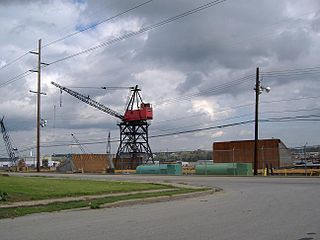
Jeffboat was a shipyard in Jeffersonville, Indiana founded by James Howard in 1834, a builder of steamboats. The company was owned by the Howard family until it was sold leading up to World War II. Following the war, it became known as the Jeffersonville Boat and Machine Company and later changed its name to Jeffboat, the more commonly used short form of its name. The company was the largest inland shipbuilder in the United States and the second-largest builder of barges before it closed in 2018.
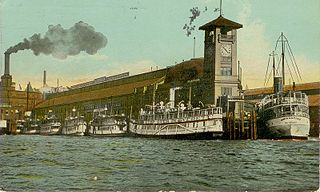
The Puget Sound mosquito fleet was a multitude of private transportation companies running smaller passenger and freight boats on Puget Sound and nearby waterways and rivers. This large group of steamers and sternwheelers plied the waters of Puget Sound, stopping at every waterfront dock. The historical period defining the beginning and end of the mosquito fleet is ambiguous, but the peak of activity occurred between the First and Second World Wars.
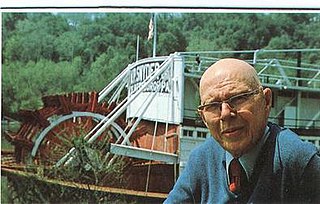
Fredrick Way Jr. was the youngest steamboat captain on the Ohio River and Mississippi River. He was the author of books on the boats that ply the inland waterways. He supervised the flat-bottom, stern paddlewheeler, the Delta Queen, from San Francisco, down the Pacific coast, through the Panama Canal, across the Gulf of Mexico and up the Mississippi and Ohio rivers to Pittsburgh in 1946.

Natchez has been the name of several steamboats, and four naval vessels, each named after the city of Natchez, Mississippi or the Natchez people. The current one has been in operation since 1975. The previous Natchez were all operated in the nineteenth century, most by Captain Thomas P. Leathers. Each of the steamboats since Leathers' first had as its ensign a cotton bale between its stacks.
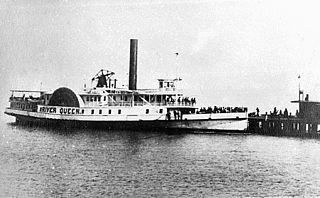
The River Queen was a sidewheel steamer which became closely associated with President Abraham Lincoln and General Ulysses S. Grant while operating on the Potomac River, and was used for an unsuccessful peace conference during the last year of the American Civil War. Later it operated as a ferry serving the islands of Martha's Vineyard and Nantucket during the late 19th century. Late in its career, it returned to the Potomac as an excursion vessel, and in 1911, it was destroyed in a fire. The boat has made numerous pop culture appearances including season one episode 13 of Scooby Doo Where are You “Which Witch is Which”.

President is a steamboat that currently lies dismantled in Effingham, Illinois. Originally named Cincinnati, it was built in 1924 and is the only remaining "Western Rivers" style sidewheel river excursion steamboat in the United States. She was listed on the National Register of Historic Places and declared a National Historic Landmark in 1989, although these designations were revoked in 2011. Her home ports have been Cincinnati, Ohio; New Orleans, Louisiana; Vicksburg, Mississippi; St. Louis, Missouri; and Davenport, Iowa.

Many steamboats operated on the Columbia River and its tributaries, in the Pacific Northwest region of North America, from about 1850 to 1981. Major tributaries of the Columbia that formed steamboat routes included the Willamette and Snake rivers. Navigation was impractical between the Snake River and the Canada–US border, due to several rapids, but steamboats also operated along the Wenatchee Reach of the Columbia, in northern Washington, and on the Arrow Lakes of southern British Columbia.

The steamboat Yosemite operated for almost fifty years on San Francisco Bay, the Sacramento River, inland coastal waters and the lower Fraser River in British Columbia, and Puget Sound.

Wilson G. Hunt was a steamboat that ran in the early days of steam navigation on Puget Sound and Sacramento, Fraser, and Columbia Rivers. She was generally known as the Hunt during her years of operation. She had a long career on the west coast of the United States and Canada, and played an important transportation role in the California Gold Rush; it also transported the Governor and the state legislature as the state capital of California moved from Benicia to Sacramento in 1854.
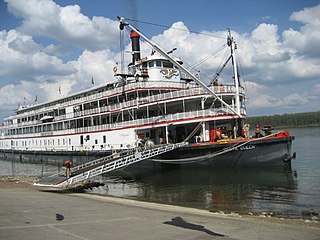
Steamboats played a major role in the 19th-century development of the Mississippi River and its tributaries, allowing practical large-scale transport of passengers and freight both up- and down-river. Using steam power, riverboats were developed during that time which could navigate in shallow waters as well as upriver against strong currents. After the development of railroads, passenger traffic gradually switched to this faster form of transportation, but steamboats continued to serve Mississippi River commerce into the early 20th century. A small number of steamboats are still used for tourist excursions in the 21st century.
Lake steamers of North America include large, steam-powered non-government vessels with displacement hulls on American freshwater lakes excluding the Great Lakes. They may have served as passenger boats, freighters, mail-boats, log-boom vessels or a combination thereof. The construction of such vessels posed unique problems on water bodies located away from established dry-docks and marine railways, or connecting canals to such facilities.
Gordon C. Greene was a paddle steamer, launched in 1923, that operated under several names before sinking in St. Louis in 1967.

Captain Thomas Rea Greene was president of the Greene Line of steamboats.

Streckfus Steamers was a company started in 1910 by John Streckfus Sr. (1856–1925) born in Edgington, Illinois. He started a steam packet business in the 1880s, but transitioned his fleet to the river excursion business around the turn of the century. In 1907, he incorporated Streckfus Steamers to raise capital and expand his riverboat excursion business. A few years later, the firm acquired the Diamond Jo Line, a steamboat packet company.
Verne Swain refers to three steamboats built by the Swain Shipyard of Stillwater, Minnesota. Swain built the first one in 1886, the second one in 1904, and the last one in 1913.

I. C. Woodward was a side-wheel packet boat launched in July 1898 by Andrew Axton & Son Co. of West Brownsville, Pennsylvania, for the Pittsburgh, Brownsville and Geneva Packet Company. She was named for ship captain Isaac C. Woodward. I. C. Woodward was 164 ft (50 m) long by 42 ft (13 m) wide with a 5 ft (1.5 m) draft. She had 50 staterooms with additional passenger room in her texas.
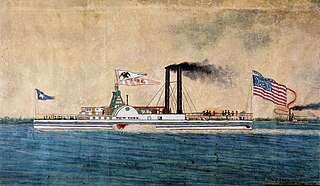
New York was an American passenger-cargo sidewheel steamboat built in 1836 for service on Long Island Sound. When new, she was the largest steamboat yet to operate on the route between New York and New Haven, Connecticut, and was one of the largest Sound steamboats of her day.




















